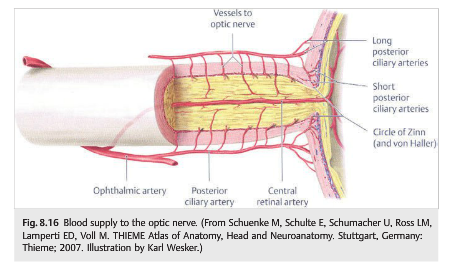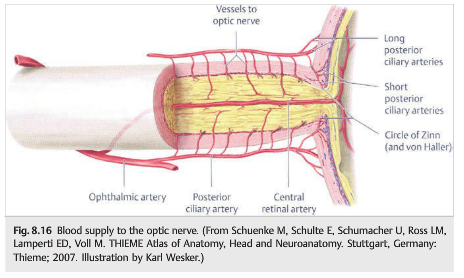Questions:
1. What is the most common optic neuropathy in patients over age 50?
2. Why are altitudinal visual field defects common in ischemic optic neuropathies?
3. Do emboli commonly cause ischemic optic neuropathy?
 1
1
____________________________________________________
Questions with answers:
1. What is the most common optic neuropathy in patients over age 50?
Ischemic Optic Neuropathy
2. Why are altitudinal visual field defects common in ischemic optic neuropathies?
Because of the anatomy of the posterior ciliary arteries, optic nerve ischemia often results in a superior (more often) or inferior segmental optic nerve atrophy. There is pallor affecting only the superior or inferior half of the optic nerve. This explains why altitudinal defects are common with ischemic optic neuropathies. Superior segmental optic atrophy results in an inferior altitudinal defect.
3. Do emboli commonly cause ischemic optic neuropathy?
No, the posterior ciliary arteries which provide the blood supply to the optic nerve head are small arteries that may be affected by several local disorders, such as atherosclerosis and vasculitis. However, emboli do not usually reach these arteries.
Explanation: “8.5 Ischemic Optic Neuropathy
Ischemic optic neuropathies are the most common acute optic neuropathies in patients over 50 years of age; they can rarely occur in younger patients, in whom they must be differentiated from other causes of optic neuropathies such as optic neuritis. The term ischemic optic neuropathy is used to refer to all presumed ischemic causes of optic neuropathy.
8.5.1 Clinical Anatomy

The posterior ciliary arteries provide the blood supply to the optic nerve (short posterior ciliary arteries to the optic nerve head and long posterior ciliary arteries to the retrobulbar optic nerve). They originate from the ophthalmic artery. These are small arteries that may be affected by several local disorders, such as atherosclerosis and vasculitis. Emboli do not usually reach these arteries (▶Fig. 8.16).
Because of the anatomy of the posterior ciliary arteries, optic nerve ischemia often results in a superior (more often) or inferior segmental optic nerve atrophy. There is pallor affecting only the superior or inferior half of the optic nerve. This explains why altitudinal defects are common with ischemic optic neuropathies. Superior segmental optic atrophy results in an inferior altitudinal defect (▶Fig. 8.17).
 ”1
”1
Pearls
Although ischemic optic neuropathies are considered the equivalent of a “stroke of the optic nerve,” they cannot be directly compared with cerebral infarctions. The causes and mechanisms of ischemic optic neuropathies are different, and the workup of a patient with an ischemic optic neuropathy is not the same as that for patients with retinal or cerebral infarction.”1
Reference:
1. Neuro-ophthalmology Illustrated-2nd Edition. Biousse V and Newman NJ. 2012. Theme
These questions are archived at https://neuro-ophthalmology.stanford.edu.
Follow https://twitter.com/NeuroOphthQandA to be notified of new neuro-ophthalmology questions of the week.
Please send feedback, questions, and corrections to tcooper@stanford.edu.